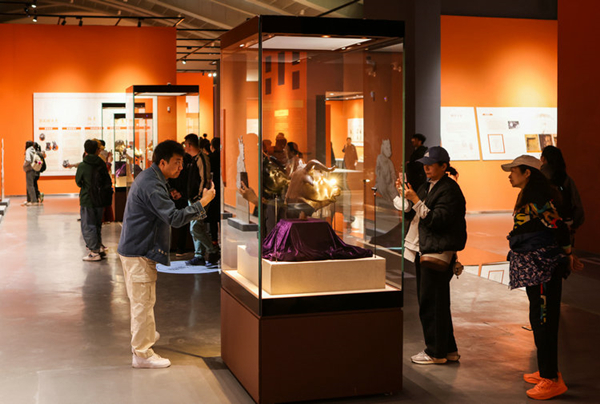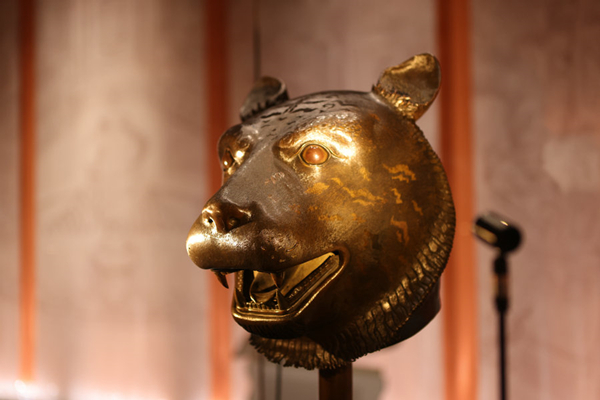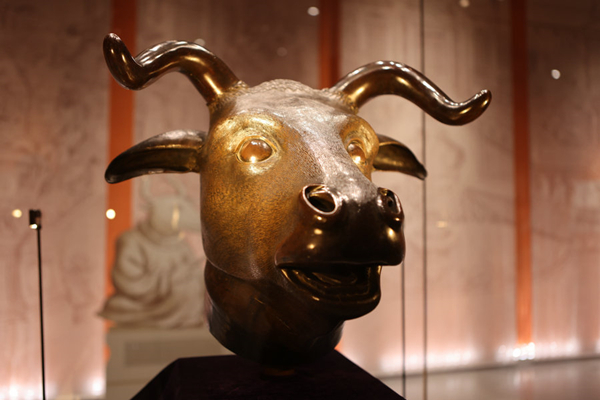Exhibition unveils reunited bronze zodiac animal heads in Yungang Grottoes
Updated: 2024-04-25

The bronze Chinese zodiac animal heads, including the ox, tiger, horse, monkey, and pig, originally from the Old Summer Palace, are on display at the Yungang Grottoes museum in Datong city, Shanxi province. [Photo provided to China Daily]

The bronze Chinese zodiac animal heads, including the ox, tiger, horse, monkey, and pig, originally from the Old Summer Palace, are on display at the Yungang Grottoes museum in Datong city, Shanxi province. [Photo provided to China Daily]

The bronze Chinese zodiac animal heads, including the ox, tiger, horse, monkey, and pig, originally from the Old Summer Palace, are on display at the Yungang Grottoes museum in Datong city, Shanxi province. [Photo provided to China Daily]
Adorned by luxurious dark violet fabric, the bronze Chinese zodiac animal heads, including the ox, tiger, horse, monkey, and pig, originally from the Yuanmingyuan Park, now glisten within the Yungang Grottoes museum in Datong city, Shanxi province.
The exhibition, The Immortality of Gold and Stone: the Seeking and Protecting Record of the Old Summer Palace and Yungang Cultural Relics, offers visitors a unique opportunity to marvel at these historic artifacts alongside the breathtaking grottoes and Buddha statues, running from April 15 to May 26.
Once part of the water clock fountain in Yuanmingyuan, or the Old Summer Palace, these bronze animal heads were looted from stone statues during the Second Opium War in 1860, and subsequently dispersed across the globe, only to be reunited through the relentless efforts of patriotic philanthropists. While the ox, tiger, monkey, and pig heads now reside in the collection of the Poly Art Museum in Beijing, the horse head is under the care of the National Cultural Heritage Administration, and the rat and rabbit heads are housed in the National Museum of China.
Regrettably, the dragon, snake, sheep, rooster, and dog heads remain missing. In the museum of Yungang Grottoes, the names of the absent bronze animal heads are displayed alongside their companions as pale, flat projections on the floor, accompanied by standing boards featuring line drawings of their complete forms, serving as a poignant reminder of their absence.
Wang Chen, deputy director of the research center of cultural heritage and art at Yungang Research Institute, highlighted the exhibition's role in igniting anticipation for the return of the missing bronze animal heads.
The exhibition also sheds light on the tragic fate of stone Buddha statues, many of which were desecrated and sold overseas during the early 20th century, with remnants now on display alongside the bronze animal heads.
Hang Kan, head of the Yungang Research Institute, emphasized the enduring significance of the relics, saying: "The metal animal heads and the stone statues shared a sad and turbulent past, but they will always carry the immortal value of the culture."
Zhao Ruichun, head of the general affairs department of Yungang Research Institute, reported an overwhelming response to the exhibition, with over 11,000 visitors in the first week.
Wan Liqun, deputy curator of Poly Art Museum, noted the exhibition's future plans, stating that after Yungang Grottoes, the bronze animal heads will journey to Guangxi Zhuang autonomous region in South China, following previous showings in Zhuhai city, Guangdong province.
While acknowledging visitor dissatisfaction at Poly Art Museum due to the display of replicas, Wan emphasized the broader goal of increasing public awareness through tour exhibitions, providing more people with the opportunity to appreciate these historic treasures.



